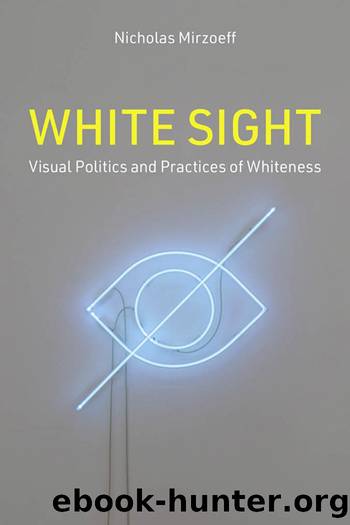White Sight by Nicholas Mirzoeff;

Author:Nicholas Mirzoeff; [Mirzoeff, Nicholas]
Language: eng
Format: epub
Tags: white; white supremacy; racism; decolonize; colonialism; race; race formation; Black Lives Matter; Whiteness; white sight; feminism; Black; BIPOC; DEI; human strike; statues; monuments; decolonizing; culture; activism; settler colonialism, British empire; imperialism; Sarah Elizabeth Lewis
Publisher: MIT Press
Published: 2023-01-23T00:00:00+00:00
6
The Cultural Unconscious and the Dispossessed
George Lammingâs way of seeing between groups placed at the margins of white seeing in the age of mass media had a general application in the decolonial contemporary. It went by way of the Caribbean, to Algeria during its decolonial revolution (1954â1962), the Black Panthers in the United States, and the Birmingham Center for Contemporary Cultural Studies under Stuart Hallâs direction.1 Such transnational networks of seeing should not be surprising. They were, after all, constitutive of modern art, to say nothing of imperialism. Global media made such networks material and instant, connecting the worldâs population in unprecedented ways. Old ideas were splintering under the new social conditions produced by the end of empire with uneven effects. Even as empire receded, ideas of racializing hierarchy surged. Tracing this line of thought makes visible the unexpected resurgence of whiteness in Euro-American politics since 1979.
With the formal decolonization of most of Europeâs empires by 1975, for people identifying as white who had once called themselves working class first and foremost, it was being white that now mattered. Building on his insights from Frantz Fanon, Hall saw how the âgreat moving right show,â which he called Thatcherism, drew its energy from this fragmentation of what had once been known as âthe class.â2 For all of his pessimism of the intellect, even Hall could not then have foreseen how far right this move would go and how long. In the final section of the book, Iâll consider how it has created the general crisis of whiteness. First, we need to think about how it got started.
Letâs begin with Lammingâs meeting with decolonial thinker Fanon in 1956 at the International Congress of Black Writers and Artists in Paris, where Fanon also used the expression âway of seeing.â Like Lammingâs moment of clarity in the ICA, the intersection of Blacks and Jews was central to Fanonâs understanding of visual encounter under colonial domination: âAnti-Jewish prejudice is no different from anti-Negro prejudice. A society has race prejudice or it has not.â3 Fanon grew up on Martinique, alongside an old Jewish community and soon found another in Algiers, where he worked as a psychiatrist. Following French-Jewish psychologist Henri Baruk, Fanon examined the cultural history of the scapegoat to analyze antisemitism. He understood both racism and antisemitism as forms of scapegoating. How could they be challenged? Rejecting Barukâs vague concept of the âmoral conscience,â Fanon framed seeing as a collective cultural process, drawing on shared knowledges. He came to realize that mass media culture was now the collective unconscious of racialization.
Who could change such global collective thinking? Fanonâs radical answer was that it would be the global dispossessed, whom he saw as the most revolutionary sector of society. Here he overturned the Marxist applecart again because it was held to be only the industrial working class or proletariat that would create any revolution. In Algiers, there were hardly any such proletarians. Instead, the cityâs shantytowns were filled with marginal and dispossessed people, known to Marxists as the lumpenproletariat.
Download
This site does not store any files on its server. We only index and link to content provided by other sites. Please contact the content providers to delete copyright contents if any and email us, we'll remove relevant links or contents immediately.
Born to Run: by Christopher McDougall(7027)
The Leavers by Lisa Ko(6875)
iGen by Jean M. Twenge(5325)
Sapiens by Yuval Noah Harari(5264)
The Kite Runner by Khaled Hosseini(5038)
Spare by Prince Harry The Duke of Sussex(4994)
Bullshit Jobs by David Graeber(3991)
Machine Learning at Scale with H2O by Gregory Keys | David Whiting(3968)
Never by Ken Follett(3703)
Goodbye Paradise(3666)
Livewired by David Eagleman(3623)
Fairy Tale by Stephen King(3156)
Harry Potter 4 - Harry Potter and The Goblet of Fire by J.K.Rowling(2942)
A Dictionary of Sociology by Unknown(2924)
The Social Psychology of Inequality by Unknown(2899)
The Club by A.L. Brooks(2812)
Will by Will Smith(2735)
0041152001443424520 .pdf by Unknown(2727)
People of the Earth: An Introduction to World Prehistory by Dr. Brian Fagan & Nadia Durrani(2673)
